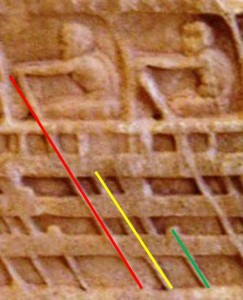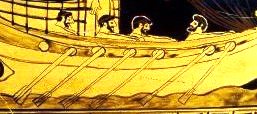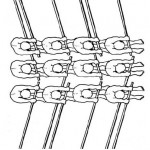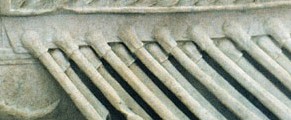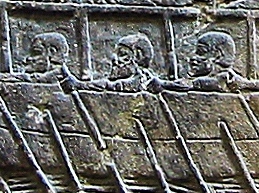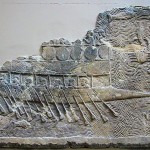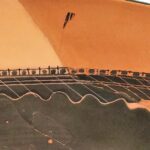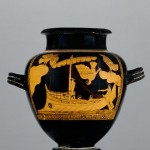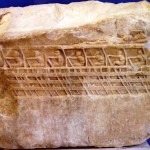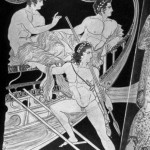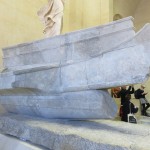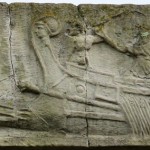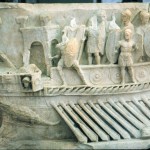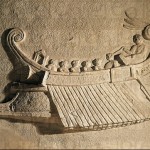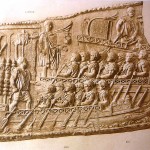The oldest pictures of rowing ships, galleys, are found on Cycladic so-called “frying pans”, from Syros Island and dated from 2800 to 2300 BC (Coleman, 1985). As they feature around 2 x 15 oars, they might be considered as ancestors of the later ‘triaconter’. The stempost (on the left) is high-rising and decorated with a fish motive, much like the later Gurob ship.
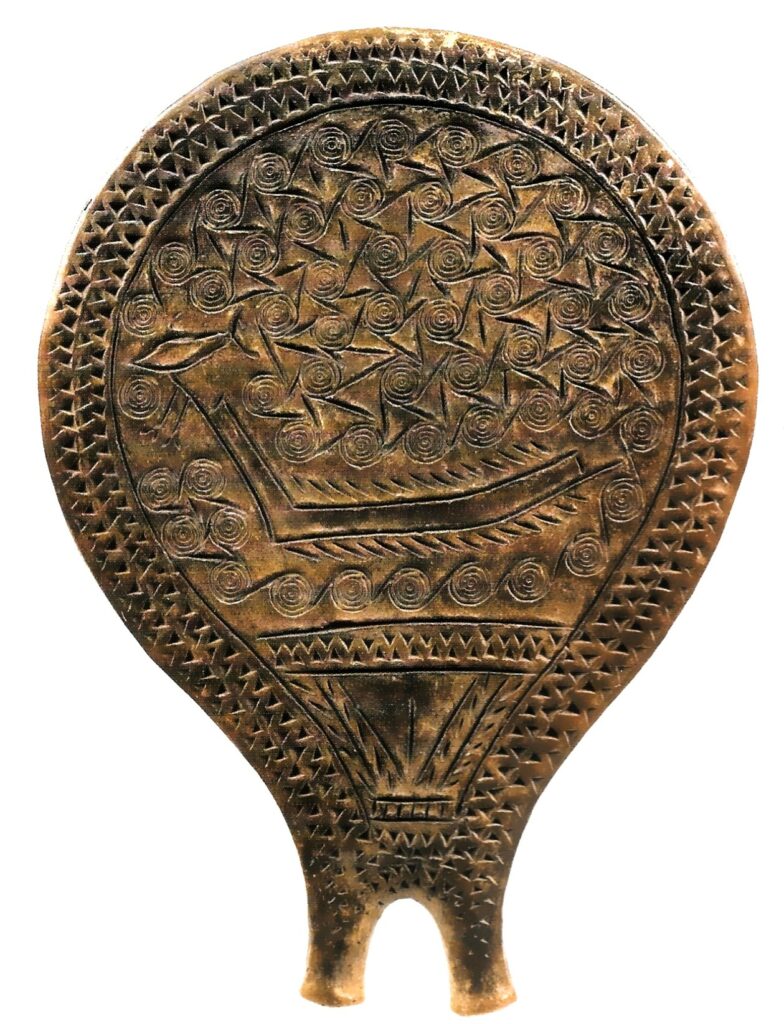
Minoans have been sailing the Aegean Sea between 2500 BC and 1500 BC, and from 1500 BC to 1200 BC, the Mycenaeans ruled the Aegean Sea and eastern Mediterranean as illustrated by Homer’s later epic on Achaeans[0] fighting the Trojan War.
The Gurob model ship is a Helladic oared galley found by Flinders Petrie in 1920 (Tomb 611 at Gurob, Egypt), and dated 1250-1050 BC[1]. It was re-discovered and analysed by S. Wachsmann[2] in 2012.
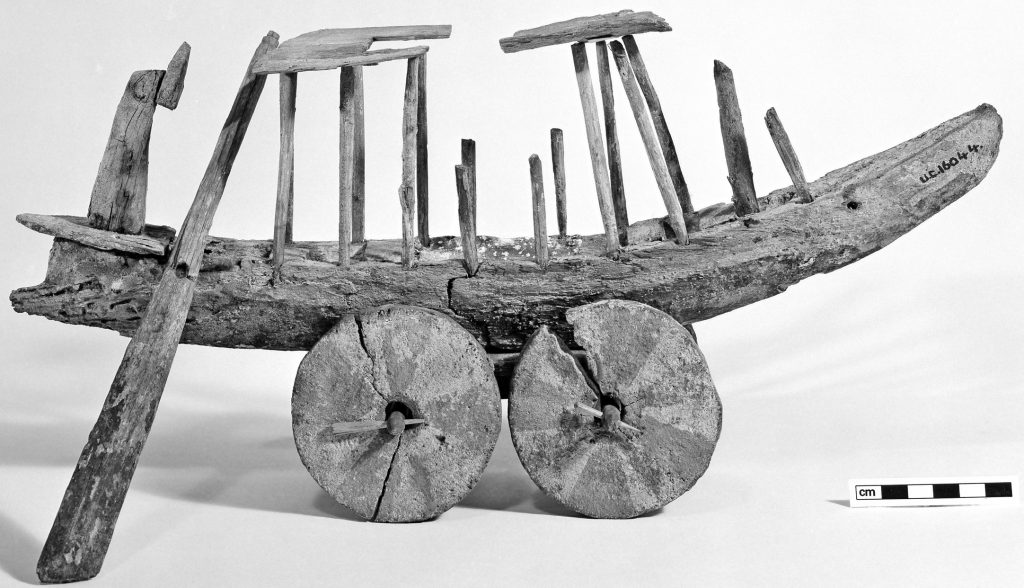
(Source : http://www.vizin.org/Gurob/Gurob_final_4PC/Gurob_VRML_html-pgs/Gurob_photo-catalogue_home.html )
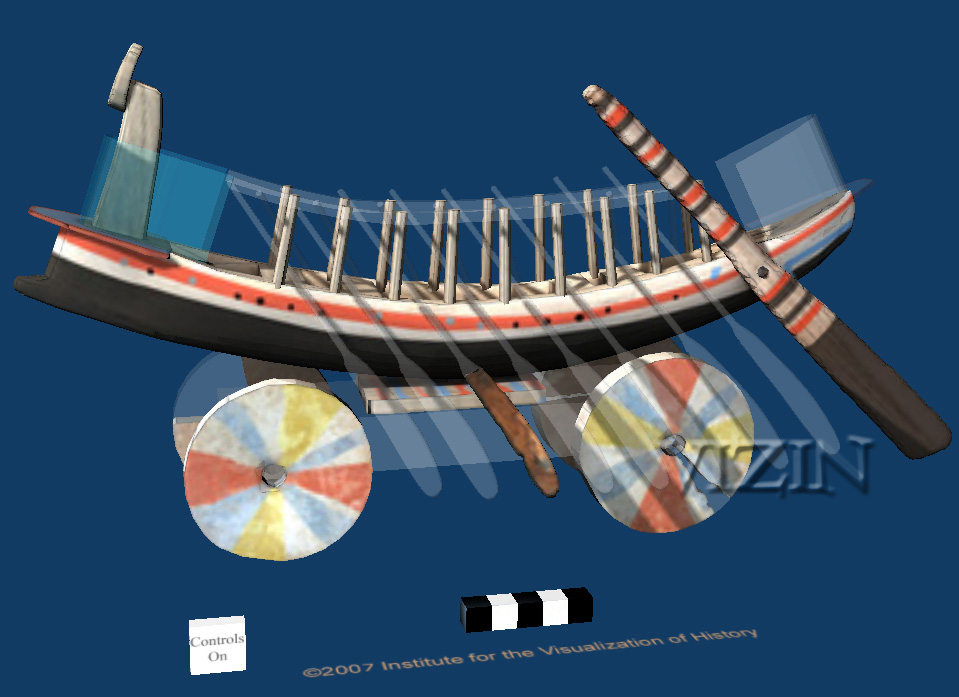
(Source : http://www.vizin.org/projects/gurob/solution.html )
By counting the number of (supposed) oarports, this ship could hardly be a model of the Homeric ‘eikosoros’ with two files of 10 rowers (Odyssey, 1, 280), but could be a ‘triaconter’ (triakontoros) with two files of 15 rowers, or even a ‘penteconter’ (pentekontoros) with two files of 25 rowers. These ships were respectively around 20 m and 30 m long, with a beam around 3 m and a draught around 0.5 m. The black hull (pitch/asphalt covered) induced the Homeric word “black ship”[3]. It is believed that Odysseus was sailing on this kind of ship and that he and his bunch of Mycenaean sailors were raiding the eastern Mediterranean coasts as far as Egypt where they may have been defeated by Ramesses II around 1277 BC, a few years before the Trojan War[4].
The Phoenicians would later include two levels of oarsmen (see Sennacherib relief below) and the Greeks would include a third level in the famous “trireme”.
While older galleys were meant for transport of ‘rowing warriors’, the trireme was a true battleship with ramming ability. Triremes first appear in Ionia and soon become the main type of battleship in the Mediterranean area from the mid-6th until the 4th century BC, then again with the Romans until the 4th century AD because of their efficiency. The trireme is considered as a major Greek ancient invention because of its speed, manoeuvrability, strength and its ease of construction. It is most certainly Athens’ main instrument of conquest at sea in the 5th century BC.
The length of the ship is 35 to 40 m, the width is less than 6 m and the maximum draught is around 1.1 m, for a total water displacement of 48 tons for a fully loaded ship (a dry light-ship has a displacement of only 25 tons with a draught of ca. 0.9 m). 170 oarsmen sit on three levels (or ‘rows’) with 85 oars per ship side. The ship is light and agile and enables the ramming manoeuvre by means of a bronze ram which is placed on the bow; this leads to the first really ‘naval’ battles. Its cruising speed under oar is around 5 to 7 knots (one knot = one nautical mile/hour = 1.8 km/h) and its top speed is 8 to 10 knots.
Oars are around 4.2 m long. Oarsmen sit with their back to the bow, like modern oarsmen. The upper oar rests on an outrigger located in the oarbox, the middle oar rests on the topwale and the lower oar passes through an oarport.
Each oar rests against a pin (called ‘rowlock’ or ‘thole’) and is attached to it with a strap (called ‘thong’). Each oarsman owns his oar, his thong and his cushion.
An open ship without an upper deck is called an ‘aphractos’ and a decked ship is called a ‘kataphractos’.
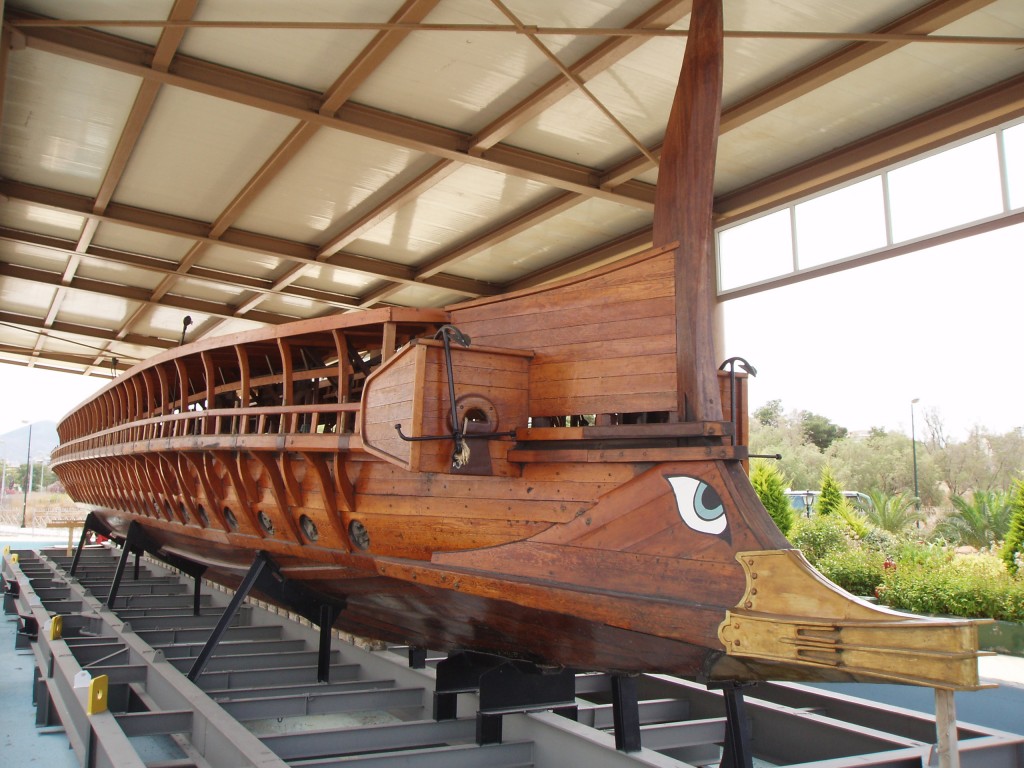
See further details in the excellent works of Morrisson, 2000 and of Rankov, 2012[5].
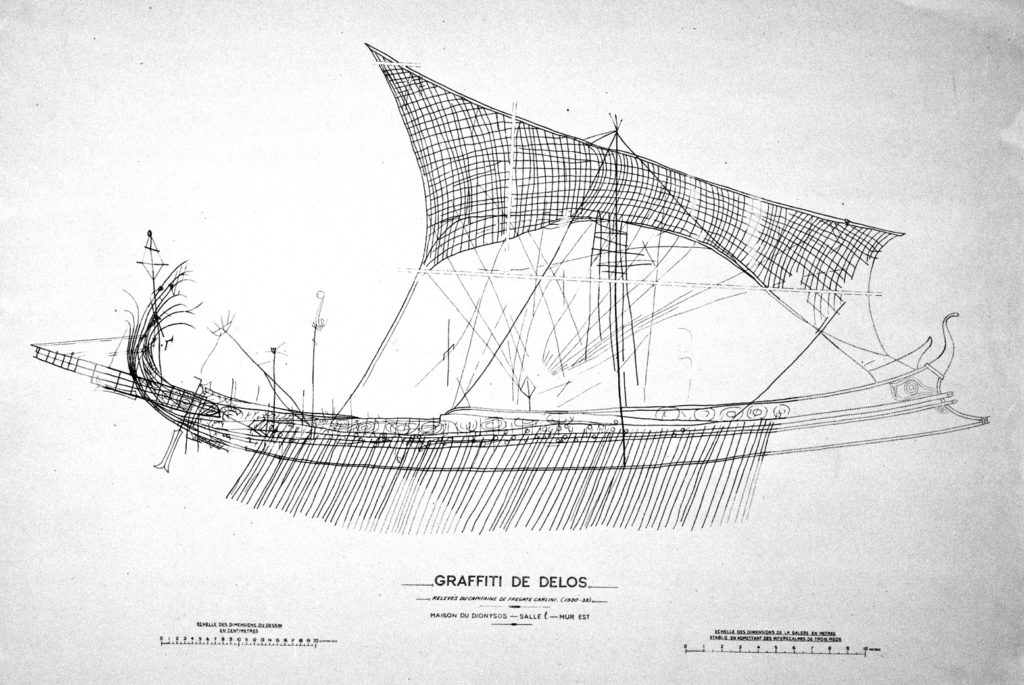
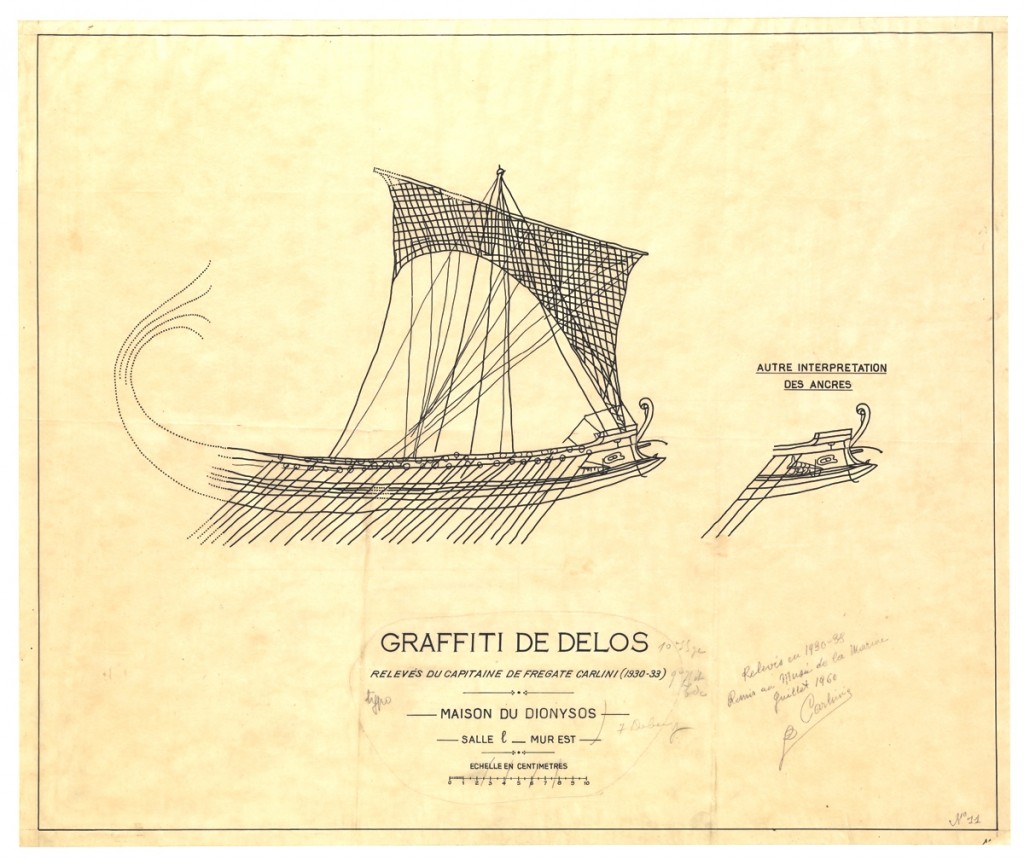
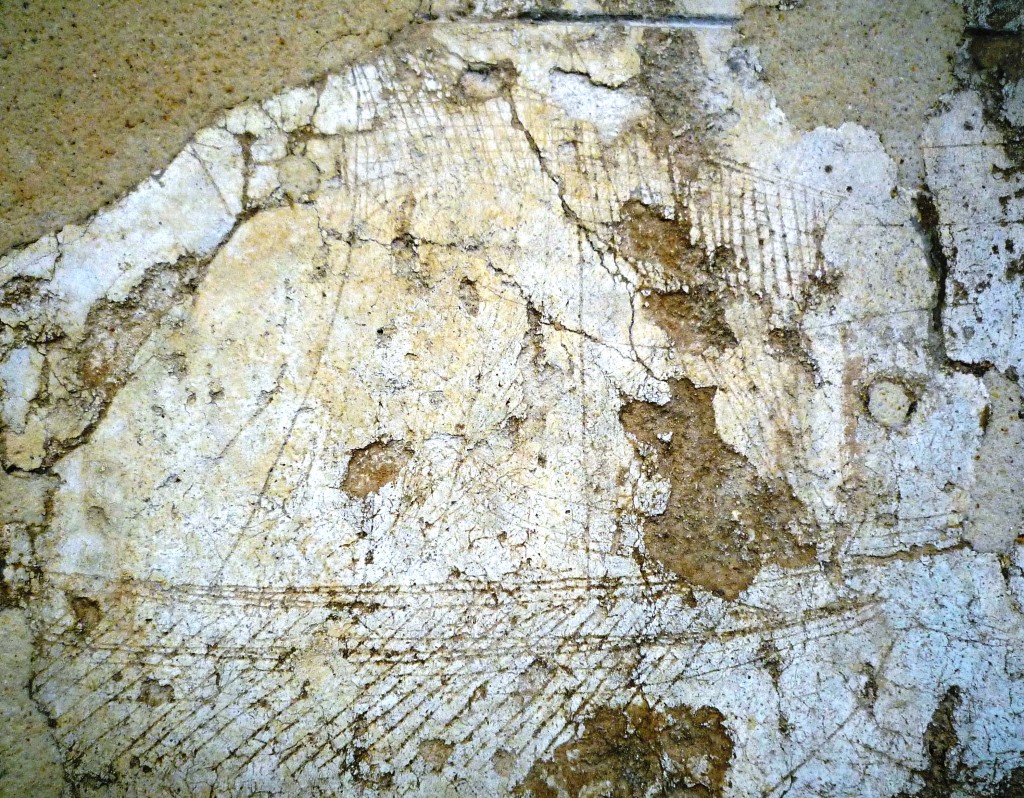
Later on, the Romans built “quinqueremes” of 40 to 45 m length and around 100-ton displacement, with ca 300 oars, each activated by one or two oarsmen.
The number 5 is related to the number of oarsmen per cell (interscalmium)
on one side of the galley:
Trireme: 1+1+1 oarsmen on 3 levels
Quadrireme: 2+2 oarsmen on 2 levels
Quinquereme: 3+2 oarsmen on 2 levels, or 2+2+1 oarsmen on 3 levels
These descriptions are mainly based on an interpretation of reliefs called “Lenormant” (above, dated 410 BC) and “Pozzuoli” (below, dated 1st c. BC to 1st C. AD) where three levels of oarsmen can be distinguished:
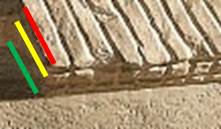 red on top (thranites),
red on top (thranites),
yellow in the middle (zygites),
green below (thalamites).
 The relief of the tomb
The relief of the tomb
of Caius Cartilius Poplicola, 25-20 BC (Ostia Antica)
also explicitly shows three levels of oars.
This approach is most widely accepted at the end of the 20th century.
However, Alec Tilley suggests another approach that is also of interest.
This approach is mainly based on an interpretation of the so-called “Siren vase” (above, dated ca 480 BC) where only one level of oarsmen is seen.
Note that the port hole of the central oarsman must be somewhat below the port hole of the lateral oarsman in order not to hinder him (e.g. 10 cm?). This might be seen on the “Samothrace Victory” (below).
The question may then be asked if this ship may be called trireme as it has groups of three oarsmen per cell (or room, Latin ‘interscalmium’, is the distance between two successive thole-pins, 0.88 to 1.05 m acc. to Rankov). Those supporting the ‘Lenormant approach’ (Morrisson, Casson, Murray, etc.) reply that the ship of the Siren vase is not a trireme but just a ship with three oarsmen on one single level.
Representations of ships with two levels are known also, without excluding the possibility of having three oarsmen (two on top and one below, which makes it a trireme) or even four (two on top and two below, which makes it a quadrireme):
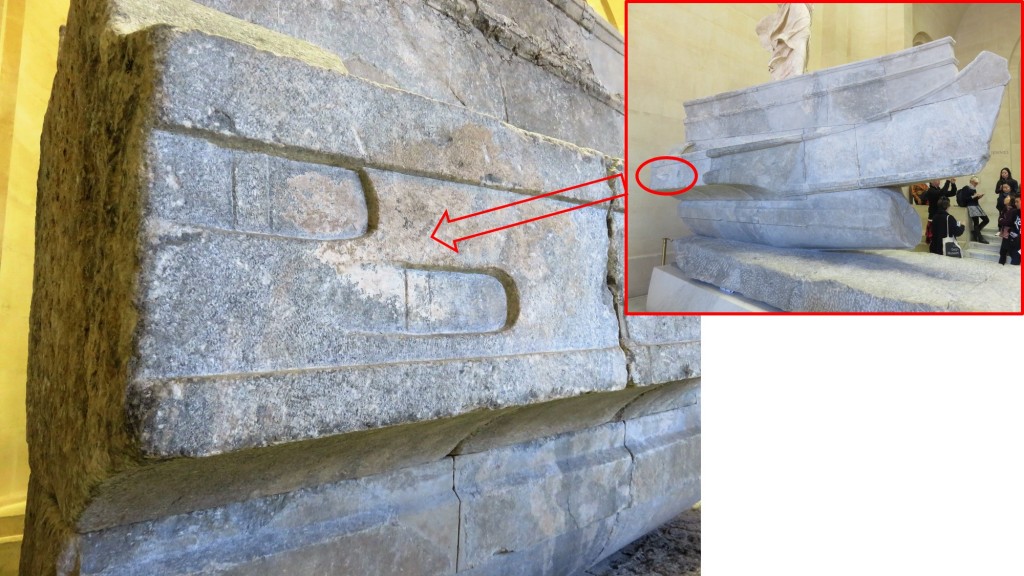
The pedestal of the statue ‘Samothrace Victory’, probably a trihemiolia dated 190 BC, (above) shows two levels of port holes. The thole-pin in each port hole seems to be shown also.
On this relief of ‘Praeneste’ of the second half of 1st c. BC (above) two levels of oars can be seen with their leather sealing sleeves. Can we ascertain that oarsmen are on different levels (Casson does it) or on the same level with slightly shifted port holes like in Tiley’s interpretation of the Siren vase?
The Assyrian so-called ‘Sennacherib’ relief of the 7th century BC (above) shows a Phoenician ship with two levels of oarsmen (according to Casson).
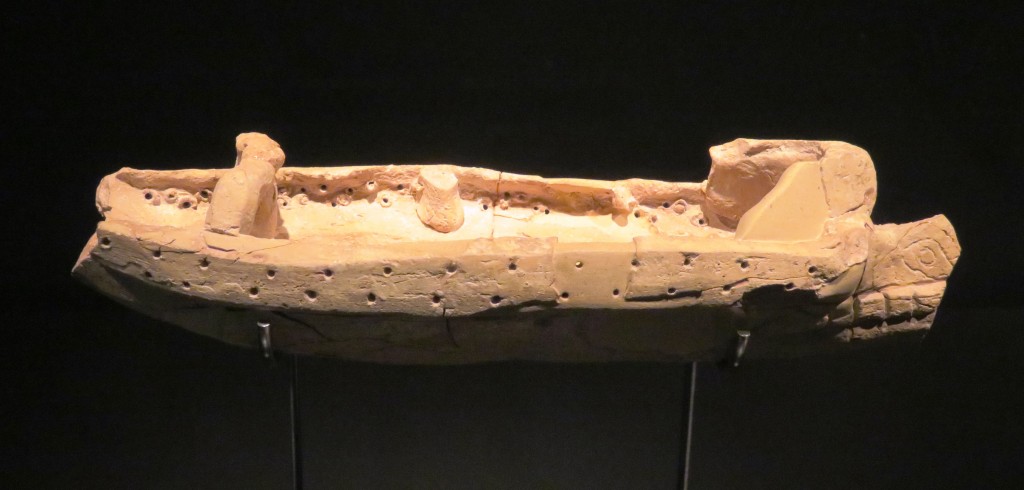
A model of a terracotta Punic bireme (above, dated ca 300 BC) to be seen in Alicante’s Museo Arqueologico also shows two levels of oarsmen (length 208 mm).
This somewhat confusing situation is also due to an evolution of definitions in ancient texts. The older texts mention the Greek word ‘pentecontore’ to designate a ship with 50 oarsmen on two longitudinal files, that is 25 oarsmen on each side of the ship. Later texts mention the Latin word ‘trireme’ to designate a ship with 3 oarsmen per cell on each side. In the old definition, one would have said ‘170’ to designate a trireme, according to the total number of oarsmen on board. Conversely, a pentecontore with one line of oarsmen per side would be called a ‘monoreme’ or a ‘one’ in the later definition. This change of definition was probably made necessary by the increasing complexity of the oar systems.
Subsequent larger galleys are therefore designated by their number of oarsmen per cell on each side of the ship: the ‘six’, ‘seven’, ‘eight’, ‘ten’, etc. until ‘eighteen’, considering that the ‘twenty’, ‘thirty’ and ‘forty’ may have been double hull ships (see tables and Murray 2012, and Pitassi 2023).
Large galleys with up to 9 men per oar will be built, but these monsters will not survive the battle of Actium (31 BC).
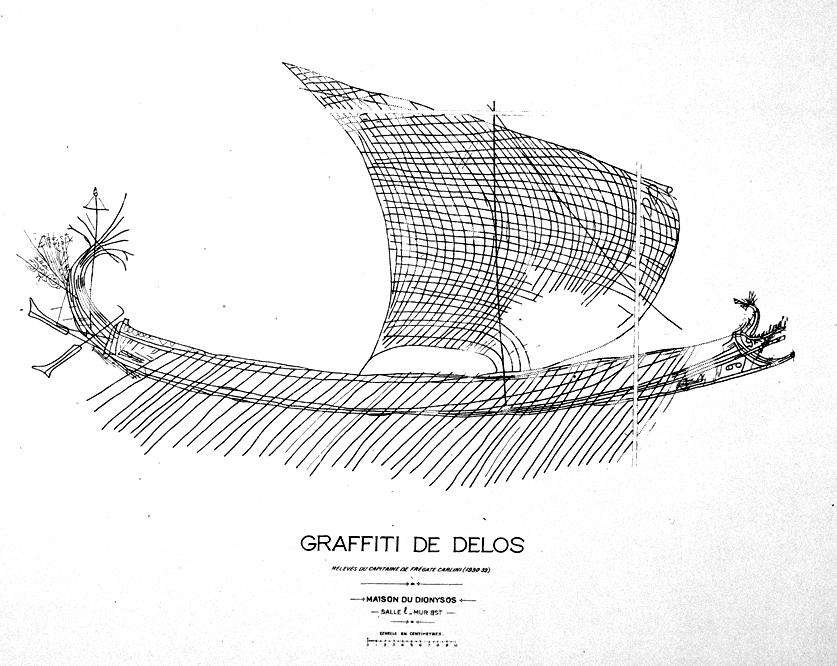
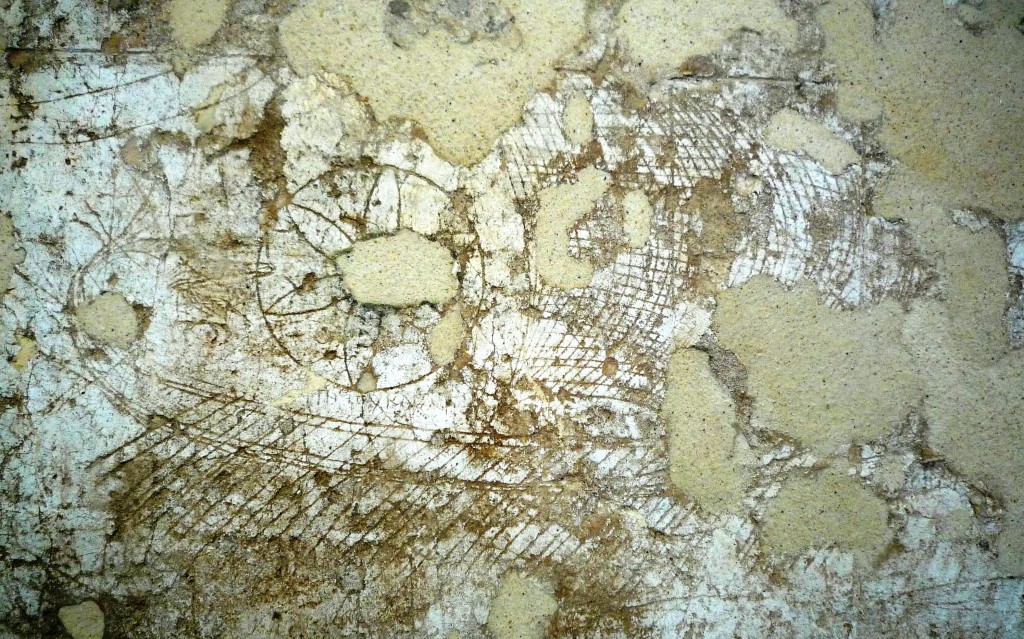
Some believe that Caligula made a replica of this ship (ca. 40 AD) which is known as the ‘Nemi II’ because it was used for naval games on Lake Nemi, north of Rome. This ship, and a second one, were found buried in the mud on the bottom of the lake, they were recovered and studied in 1927-32, but unfortunately disappeared during a fire in 1944[6].
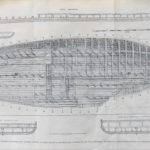
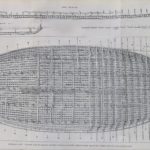
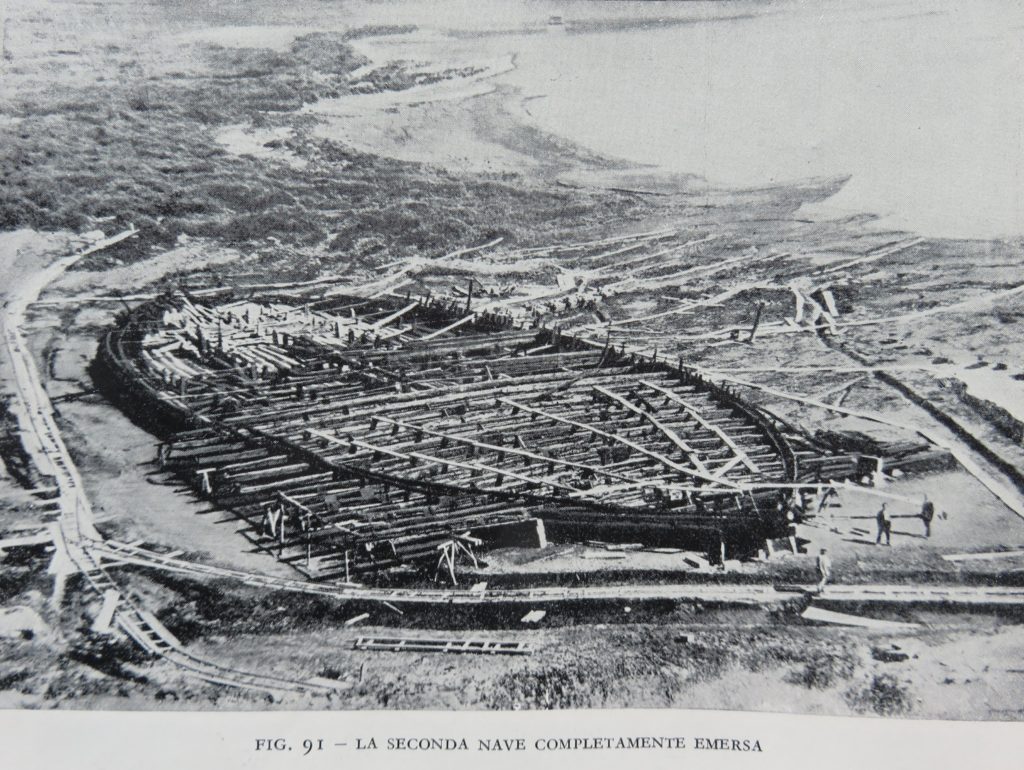
Ship size 73 x 24 m, note the size of the persons standing in front of the ship.
The following ships are presented in the 3 tables hereafter:
- known ancient maxi-ships
- other ancient ships
- pm: other galleys
Complete pictures of the details shown above are given hereafter.
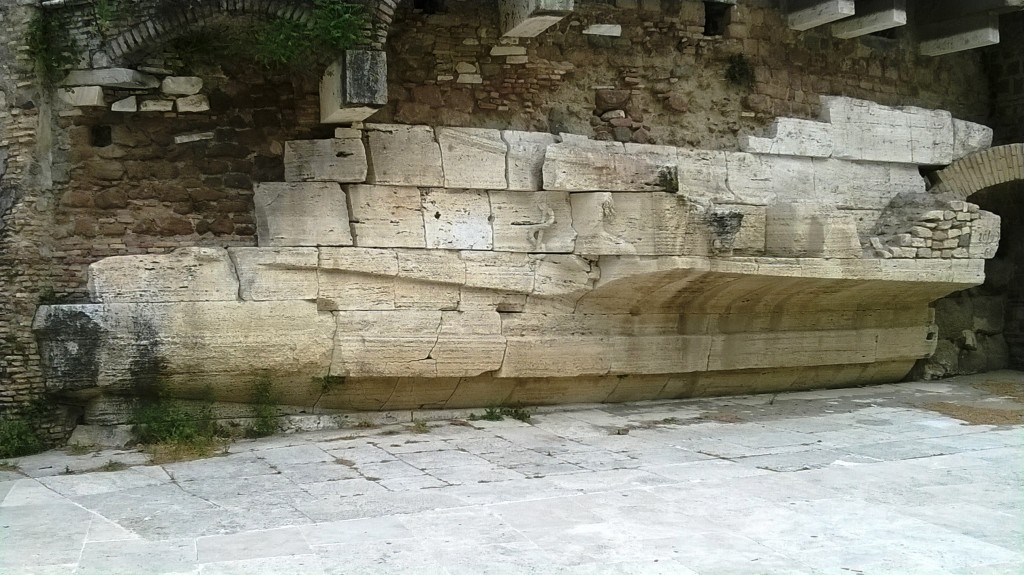
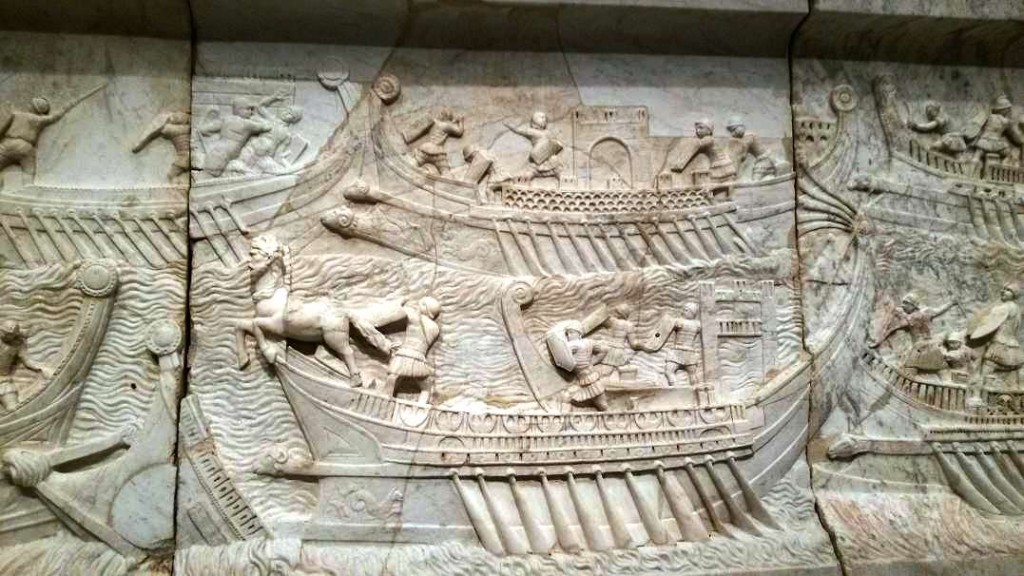
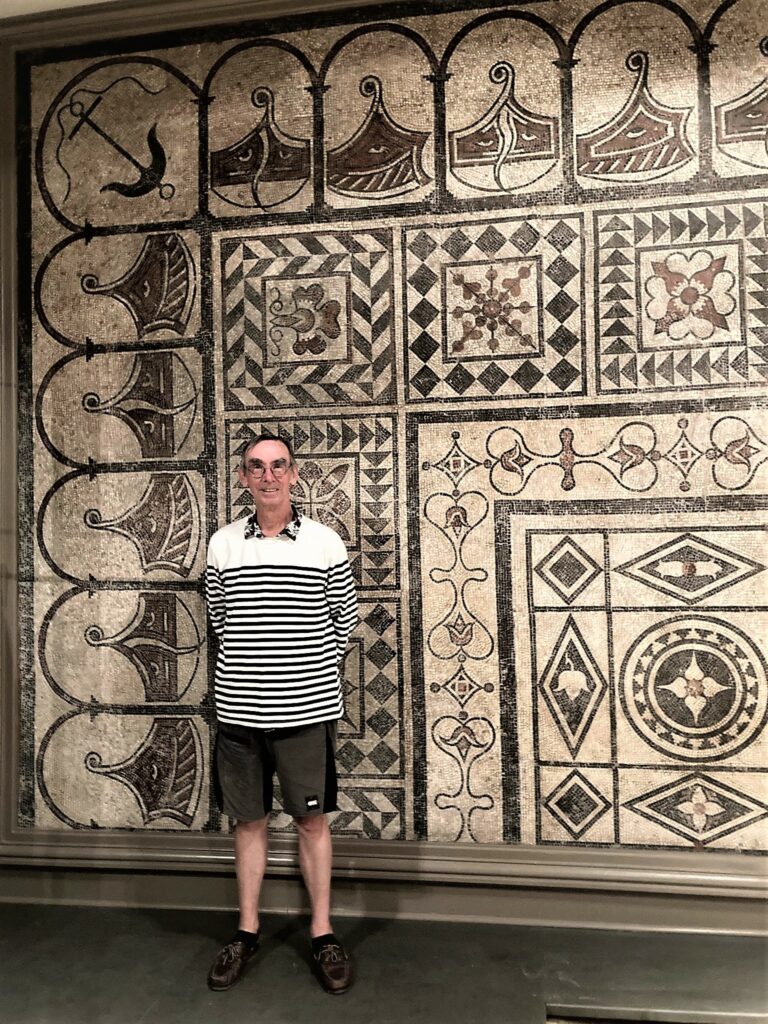
dated 2nd or 3rd c. AD, see J-C. Béal, 2017 (photo: A de Graauw, 2023).
Notes
[0] Achaeans were also called Argives (or Danaans) by Homer, and Ahhiyawans by the Hittites and Denyen (or Danuna, Tanaju, Tanaya) by the Egyptians; today they are called ‘Mycenaeans’.
[1] EMANUEL, J., 2012, “Cretan Lie and Historical Truth: Examining Odysseus’ Raid on Egypt in its Late Bronze Age Context”, In V. Bers, D. Elmer, D. Frame, & L. Muellner (Ed.), Donum Natalicium Digitaliter Confectum Gregorio Nagy Septuagenario a Discipulis Collegis Familiaribus Oblatum (p 1-41). Washington, DC, Center for Hellenic Studies.
EMANUEL, J., 2017, “Black Ships and Sea Raiders, The Late Bronze and Early Iron Age Context of Odysseus’ Second Cretan Lie”, Lexington Books, Lanham, (228 p).
[2] WACHSMANN, S., 2013, “The Gurob Ship-Cart Model and Its Mediterranean Context”, Ed Rachal Foundation Nautical Archaeology Series, Texas A&M University Press.
[3] See Ramesses II’s letter to the Hittite king Hattusili III (KUB III 82, around 1250 BC) about pitching the hull to ensure water-tightness.
For further reading on ancient galleys, see nicely illustrated work of Adrian WOOD, 2012, “Warships of the Ancient World – 3000-500 BC”, Osprey Publishing, Oxford, UK, (48 p).
[4] EMANUEL, J., 2014, “Odysseus’ Boat? New Mycenaean Evidence from the Egyptian New Kingdom”. In Discovery of the Classical World: An Interdisciplinary Workshop on Ancient Societies, a lecture series presented by the department of The Classics at Harvard University. Cambridge, MA.
The type of boat can also be deduced from the Odyssey, Book 10, 265: “So I split up my well-armed comrades in two separate groups, each with its own leader. I commanded one, and godlike Eurylochus the other. We shook tokens in a helmet made of bronze. When brave Eurylochus’s lot fell out, he set off with twenty-two companions, all in tears, leaving us behind to grieve.” So, if they had a triaconter with 30 oarsmen, Odysseus would end up with 8 companions (or 28 if they had a penteconter). Odysseus being the leader and the hero, he should have taken a smaller group than Eurylochus, i.e. a group of 8 and not a group of 28. They must therefore have had a triaconter with 30 oarsmen, and not a penteconter.
[5] MORRISON, J.S.; COATES, J.F.; RANKOV, N.B., 2000, “The Athenian Trireme”, Cambridge University Press, 2000, (319 p);
RANKOV, B., 2012, “Trireme Olympias, The Final Report”, Oxbow Books, Oxford, (243 p).
[6] UCELLI, G., 1950, “Le Navi di Nemi”, Libreria dello Stato, Roma, (386 p).

